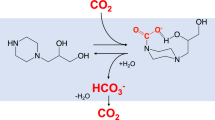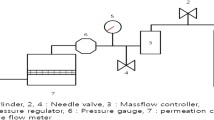Abstract
Substitution of thiourea to poly(diphenylacetylene) having 2-bromoethoxy groups (2a) gave an sulfonium-containing poly(diphenylacetylene) [3a (Br − )]. The counteranions of 3a (Br − ) could be exchanged using CF3COOK and (CF3SO2)2NLi, and the polymers 3a (TFAc − ) and 3a (Tf 2 N − ) were obtained. Polymer 3a (Br − ) was hydrolyzed with NaOHaq to afford the polymer 4a possessing mercapto groups. The CO2 permeability coefficients (\(P_{{{\text{CO}}_{ 2} }}\)) and the separation factor (\(P_{{{\text{CO}}_{ 2} }} /P_{{{\text{N}}_{ 2} }}\)) of 3a (Br − ) were 15 barrers and 16, respectively. The selectivity was low compared to the analogous polymer, poly(diphenylacetylene) having imidazolium salts (\(P_{{{\text{CO}}_{ 2} }} /P_{{{\text{N}}_{ 2} }} = 4 4\)), because 3a (Br − ) interacted strongly with CO2, and the diffusion of CO2 was suppressed. The \(P_{{{\text{CO}}_{ 2} }}\) and \(P_{{{\text{CO}}_{ 2} }} /P_{{{\text{N}}_{ 2} }}\) of 3a (TFAc − ) were 43 barrers and 24, respectively, and those of 3a (Tf 2 N − ) were 52 barrers and 26, respectively. Both permeability and selectivity increased as the counteranion became bulkier. The mercapto group containing poly(diphenylacetylene) (4a) showed a relatively high CO2 permeability (\(P_{{{\text{CO}}_{ 2} }} = 1 30\) barrers).





Similar content being viewed by others

References
Masuda T, Isobe E, Higashimura T, Takada K (1983) Poly[1-(trimethylsilyl)-1-propyne]: a new high polymer synthesized with transition metal catalysts and characterization by extremely high gas permeability. J Am Chem Soc 105:7473–7474
Tsuchihara K, Masuda T, Higashimura T (1991) Tractable silicon-containing poly(diphenylacetylenes): their synthesis and high gas permeability. J Am Chem Soc 113:8548–8589
Tsuchihara K, Masuda T, Higashimura T (1992) Polymerization of silicon-containing diphenylacetylenes and high gas permeability of the product polymers. Macromolecules 25:5816–5820
Kouzai H, Masuda T, Higashimura T (1994) Synthesis and properties of poly(diphenylacetylenes) having aliphatic para-substituents. J Polym Sci Part A Polym Chem 32:2523–2530
Sakaguchi T, Kwak G, Masuda T (2002) Synthesis of poly(1-β-naphthyl-2-phenylacetylene) membranes through desilylation and their properties. Polymer 43:3937–3942
Sakaguchi T, Shiotsuki M, Masuda T (2004) Synthesis and properties of Si-containing poly(diarylacetylene)s and their desilylated polymer membranes. Macromolecules 37:4104–4108
Nagai K, Masuda T, Nakagawa T, Freeman BD, Pinnau I (2001) Poly[1-(trimethylsilyl)-1-propyne] and related polymers: synthesis, properties, and functions. Prog Polym Sci 26:721–798
Sakaguchi T, Yumoto K, Shida Y, Shiotsuki M, Sanda F, Masuda T (2006) Synthesis, properties, and gas permeability of novel poly(diarylacetylene) derivatives. J Polym Sci Part A Polym Chem 44:5028–5038
Shiotsuki M, Sanda F, Masuda T (2011) Polymerization of substituted acetylenes and features of the formed polymers. Polym Chem 2:1044–1058
Figueroa JD, Fout T, Plasynski S, Mcllvried H, Srivastava RD (2008) Advanced in CO2 capture technology—the U.S. Department of Energy’s Carbon Sequestration Program. Int J Greenhouse Gas Control 2:9–20
Baker RW, Low BT (2014) Gas separation membrane materials: a perspective. Macromolecules 47:6999–7013
Huang Y, Merkel TC, Baker RW (2014) Pressure ratio and its impact on membrane gas separation processes. J Membr Sci 463:33–40
Merkel TC, Lin H, Wei X, Baker RW (2010) Power plant post-combustion carbon dioxide capture: an opportunity for membranes. J Membr Sci 359:126–139
Sakaguchi T, Hashimoto T (2014) Synthesis of poly(diphenylacetylene)s bearing various polar groups and their gas permeability. Polym J 46:391–398
Liu J, Hou X, Park HB, Lin H (2016) High-performance polymers for membrane CO2/N2 separation. Chem Eur J 22:1–12
Dai Z, Noble RD, Gin DL, Zhang X, Deng L (2016) Combination of ionic liquids with membrane technology: a new approach for CO2 separation. J Membr Sci 497:1–20
Lin H, Freeman BD (2005) Materials selection guidelines for membranes that remove CO2 from gas mixtures. J Mol Struct 739:57–74
Sakaguchi T, Kameoka K, Hashimoto T (2008) Synthesis and gas permeability of novel poly(diphenylacetylenes) having polyethylene glycol moieties. Polym Bull 60:441–448
Sakaguchi T, Kameoka K, Hashimoto T (2009) Synthesis of PEG-functionalized poly(diphenylacetylene)s and their gas permeation properties. J Appl Polym Sci 113:3504–3509
Sakaguchi T, Kameoka K, Hashimoto T (2009) Synthesis of sulfonated poly(diphenylacetylene)s with high CO2 permselectivity. J Polym Sci Part A Polym Chem 47:6463–6471
Sakaguchi T, Takeda A, Hashimoto T (2011) Highly gas-permeable silanol-functionalized poly(diphenylacetylene)s: synthesis, characterization, and gas permeation properties. Macromolecules 44:6810–6817
Sakaguchi T, Shinoda Y, Hashimoto T (2012) A series of poly(diphenylacetylene)s bearing sulfonic acids: synthesis, characterization, and gas permeability. Polymer 53:5268–5274
Sakaguchi T, Shinoda Y, Hashimoto T (2014) Synthesis and gas permeability of nitrated and aminated poly(diphenylacetylene)s. Polymer 55:6680–6685
Sakaguchi T, Tsuzuki T, Masuda T, Hashimoto T (2014) Synthesis, gas permeability, and metal-induced gelation of poly(disubstituted acetylene)s having p,m-dimethoxyphenyl and p,m-dihydroxyphenyl groups. Polymer 55:1977–1983
Sakaguchi T, Ito H, Masuda T, Hashimoto T (2013) Highly CO2-permeable and -permselective poly(diphenylacetylene)s having imidazolium salts: synthesis, characterization, gas permeation properties, and effects of counter anion. Polymer 54:6709–6715
Bara JE, Carlisle TK, Gabriel CJ, Camper D, Finotello A, Gin DL, Noble RD (2009) Guide to CO2 separations in imidazolium-based room-temperature ionic liquids. Ind Eng Chem Res 48:2739–2751
Scovazzo P, Kieft J, Finan DA, Koval C, Dubois D, Noble R (2004) Gas separations using non-hexafluorophosphate [PF6]− anion supported ionic liquid membranes. J Membr Sci 238:57–63
Bara JE, Lessmann S, Gabriel CJ, Hatakeyama ES, Noble RD, Gin DL (2007) Synthesis and performance of polymerizable room-temperature ionic liquids as gas separation membranes. Ind Eng Chem Res 46:5397–5404
Carlisle TK, Bara JE, Lafrate AL, Gin DL, Noble RD (2010) Main-chain imidazolium polymer membranes for CO2 separations: an initial study of a new ionic liquid-inspired platform. J Membr Sci 359:37–43
Robeson LM (2008) The upper bound revisited. J Membr Sci 320:390–400
Author information
Authors and Affiliations
Corresponding author
Rights and permissions
About this article
Cite this article
Sakaguchi, T., Kaji, S. & Hashimoto, T. Synthesis and CO2 permeation properties of novel sulfonium-substituted poly(diphenylacetylene)s. Polym. Bull. 75, 3011–3022 (2018). https://doi.org/10.1007/s00289-017-2195-8
Received:
Revised:
Accepted:
Published:
Issue Date:
DOI: https://doi.org/10.1007/s00289-017-2195-8



